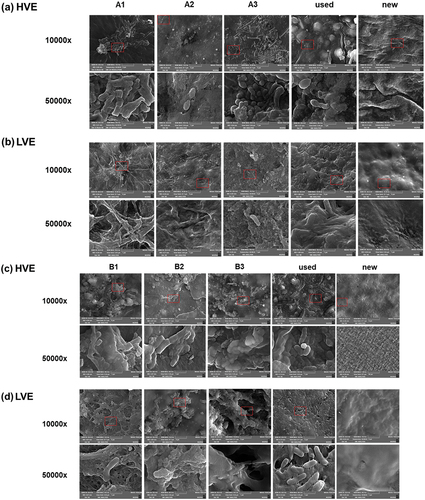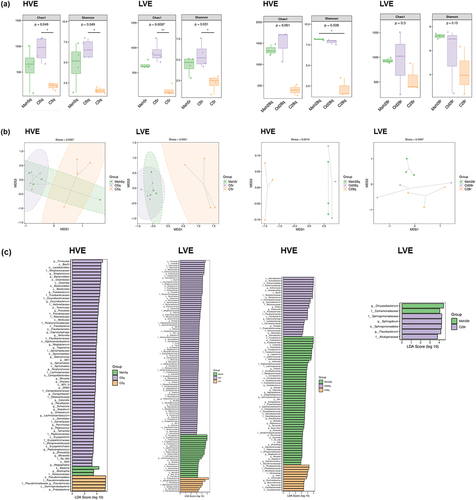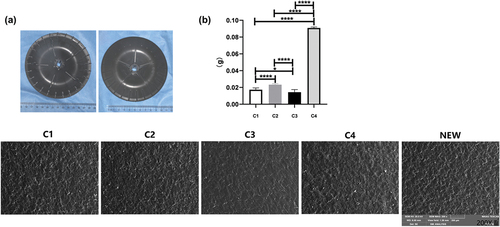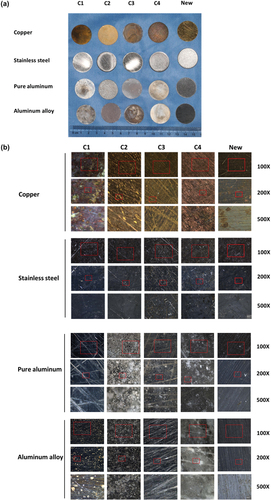Figures & data
Table 1. Counting of bacterial cultures in eluates of pipelines disinfected by group A1, A2, A3 for 5 days and by group B1, B2, B3 for 4 weeks.
Figure 1. Bacteria species, number, and structure in biofilms of pipelines which are new, used or disinfected by different methods are observed under SEM. (a) Biofilms in the HVE pipelines. (b) Biofilms in the LVE pipelines. (c) Biofilms in the HVE pipelines. (d) Biofilms in the LVE pipelines. A1 (control group, n=5), 1:100 multi-enzyme detergent plus 3% H2O2, 5 days. A2 (experimental group, n=5), original solution of double-chain quaternary ammonium salt disinfectant, 5 days. A3 (experimental control group, n=5), chlorine disinfectant (500mg/L available chlorine), 5 days. B1 (control group, n=5), 1:100 multi-enzyme detergent plus 3% H2O2, 4 weeks. B2 (experimental group, n=5), double-chain quaternary ammonium salt disinfectant diluent (1:50), 4 weeks. B3 (control group, n=5), chlorine disinfectant (500mg/L available chlorine), 4 weeks. The area in the red box of the image at 10000x is magnified to be viewed at 50000x.

Figure 2. Gene sequencing results for biofilms of pipelines. (a) α-diversity: Chao1 index (abundance) and Shannon index (diversity) of biofilms in pipelines under different disinfection methods. (b) β-diversity: graph of NMDS analysis results. (c) LEfSe (LDA effect size) analysis: means of finding bacteria that differ between groups. *Meh5q and Meh5r (control group), HVE and LVE pipelines disinfected by 1:100 multi-enzyme detergent plus 3% H2O2 for 5 days. O5q and O5r (experimental group), HVE and LVE pipelines disinfected by original solution of double-chain quaternary ammonium salt disinfectant for 5 days. C5q and C5r (control group), HVE and LVE pipelines disinfected by chlorine disinfectant (500mg/L available chlorine) for 5 days. Meh28q and Meh28r (control group), HVE and LVE pipelines disinfected by 1:100 multi-enzyme detergent plus 3% H2O2 for 28 days. Od28q and Od28r (experimental group), HVE and LVE pipelines disinfected by double-chain quaternary ammonium salt disinfectant diluent (1:50) for 28 days. C28q and C28r (control group), HVE and LVE pipelines disinfected by chlorine disinfectant (500mg/L available chlorine) for 28 days.

Figure 3. Influence of different disinfection methods on air quality. (a) Air samples taken in pipes disinfected by stock double-chain quaternary ammonium salt disinfectant for 5 days. (b) Air samples taken in pipes disinfected by double-chain quaternary ammonium salt disinfectant dilution for 4 weeks.

Table 2. Bacterial culture results of biofilms and eluates from pipelines with different disinfection methods.
Figure 4. Corrosion effects of different disinfectants on the pipeline fittings. (a) A new pipeline fitting attached to the negative pressure system called moisture separation cover (made of PP-TD30). (b) Weights of corrosion effects of different disinfectants on moisture separation covers. (c) SEM images of the new and disinfected moisture separation covers. One asterisk indicates a significant difference from all other groups (p < 0.05), four asterisks indicate a significant difference from all other groups (p < 0.0001).

Table 3. Weights of corrosion effects of different disinfectants on moisture separation covers.
Figure 5. Observation of metal sheets immersed in different disinfectants. (a) Appearance of new metal sheets and metal sheets soaked in four disinfectants for 3 months. (b) Surface of the metal sheets observed under SEM. *C1 (control group), 1:100 multi-enzyme cleaners+3% H2O2, 3 months. C2 (experimental group), double-chain quaternary ammonium salt disinfectant stock solution, 3 months. C3 (experimental group), double-chain quaternary ammonium salt disinfectant diluent (1:50), 3 months. C4 (control group), chlorine disinfectant (500mg/L available chlorine), 3 months. The area in the red box of the image is magnified to be observe with a larger field of view.

